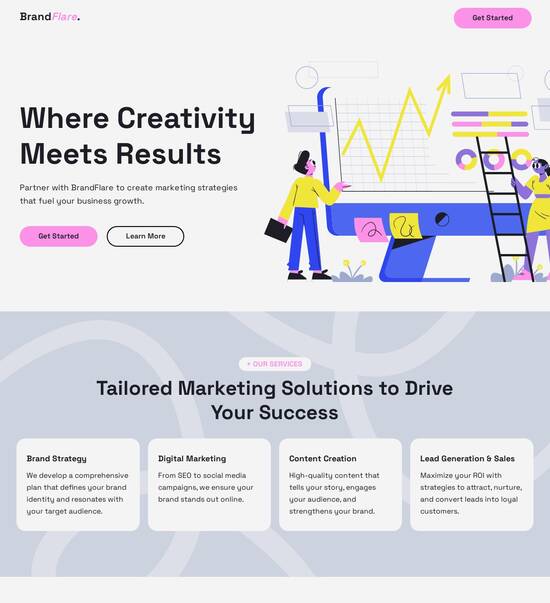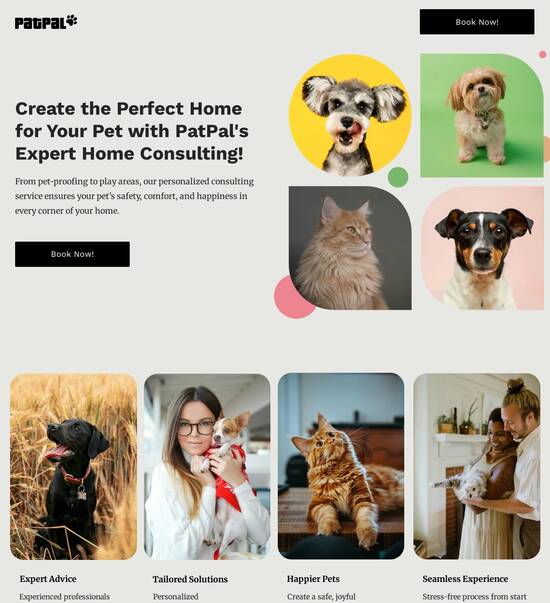
React.js optimized job portal template
Explore Similar TemplatesAbout template
Leverage our intuitive page builder and high-converting React.js optimized job portal template.
Recommended templates

Easy to build without coding
With the intuitive drag-and-drop builder, anyone on your team can create high-converting pages without any knowledge of code or design. Make enhancements to your landing page with custom widgets using Javascript, HTML/CSS, or third-party scripts.

Multiple layouts for any industry and goal
Select from 500+ landing page layouts built to boost conversions across industry-specific scenarios. Customize them by adjusting fonts, adding images, and generating on-brand content with the AI assistant. Quickly scale with Instablocks® and Global Blocks that you can save, reuse, and update globally.

Loads fast and looks polished on any device
Every template is responsive, which means they present professionally on any device and load blazingly fast with our Thor Render Engine. You can also power them up with Google AMP technology to deliver an unparalleled mobile experience and drive higher conversions.

Robust analytics & experimentation
Get real-time updates and reporting across all your devices, showing the number of visitors, conversions, cost-per-visitor, and cost-per-lead. Launch AI-powered experiments, run A/B tests, and use heatmaps to analyze user behavior, then optimize your landing page to maximize conversions.







Easy to build without coding
With the intuitive drag-and-drop builder, anyone on your team can create high-converting pages without any knowledge of code or design. Make enhancements to your landing page with custom widgets using Javascript, HTML/CSS, or third-party scripts.
Multiple layouts for any industry and goal
Select from 500+ landing page layouts built to boost conversions across industry-specific scenarios. Customize them by adjusting fonts, adding images, and generating on-brand content with the AI assistant. Quickly scale with Instablocks® and Global Blocks that you can save, reuse, and update globally.
Loads fast and looks polished on any device
Every template is responsive, which means they present professionally on any device and load blazingly fast with our Thor Render Engine.
Robust analytics & experimentation
Get real-time updates and reporting across all your devices, showing the number of visitors, conversions, cost-per-visitor, and cost-per-lead. Launch AI-powered experiments, run A/B tests, and use heatmaps to analyze user behavior, then optimize your landing page to maximize conversions.
All the features you need to build lead-generating landing pages
Explore more featuresLearn how to build top-performing landing pages for any goal
FAQs
Leading the way in building high-performing landing pages





A comprehensive guide to Instapage for maximizing your landing page and CRO strategy
With digital marketing constantly evolving, understanding how to effectively use a powerful tool like Instapage can significantly impact your campaign outcomes. This guide dives into the capabilities of Instapage, showcasing how its features can accelerate, optimize, scale, and enhance the ROI of your campaigns. From marketers in technology and services to those in education and finance, this guide provides valuable insights into leveraging landing pages effectively.
Understanding the importance of landing pages
Landing pages play a crucial role in digital campaigns, acting as the first touchpoint that can lead to conversions. Effective landing pages should be designed to meet specific goals — whether that's capturing leads, promoting products, or driving traffic. Prioritizing specific elements can enhance conversion rates:
- Clear messaging: Ensure your value proposition is immediately visible to guide users toward desired actions.
- Strategic design: Use engaging visuals that align with your branding to draw attention and maintain interest.
- Strong CTAs: Incorporate compelling calls-to-action that prompt immediate user engagement.
Step 1: Choosing the right template for your landing page
Selecting an appropriate template from Instapage's extensive library is the first step toward crafting effective landing pages. Consider the following criteria when making your choice:
- Relevance: Choose templates tailored for your specific industry or campaign goals to resonate with your target audience.
- Customization capabilities: Ensure the template allows for modifications to align with your brand standards.
- Conversion potential: Opt for layouts that feature high-converting elements proven through analytics.
Step 2: Optimizing your landing page content
Once your template is set, focus on optimizing the content. A/B testing various elements allows you to identify what resonates with your audience. Key focus areas include:
- Headlines: Experiment with different versions of headlines to see which attracts more clicks.
- Imagery: Test visuals to find which images reduce bounce rates and improve user engagement.
- Forms: Modify form lengths to minimize friction and increase lead submissions.
Step 3: Analyzing performance and iterating
After launching, continuously monitor performance using Instapage's analytics tools. The insights gained will allow you to make informed decisions for future campaigns, iterating on your designs for better outcomes.
In conclusion, utilizing Instapage effectively can significantly enhance your marketing campaigns. With the right templates, optimized content, and continuous analysis, your landing page strategy will lead to better conversions and ROI.
Ready to take your marketing campaigns to the next level? Sign up for Instapage today and start harnessing the power of optimized landing pages for your business.
ReactJS optimized job portal template: a comprehensive guide
Understanding the landscape of job portals with ReactJS
The job search landscape has transformed significantly over the years, evolving from traditional print advertisements to fast-paced digital platforms. In the past, job seekers relied heavily on newspapers and bulletins for employment opportunities, but the rise of the internet has changed all that. The shift to online job portals provided a more extensive reach and ease of access, allowing candidates to browse opportunities instantly. Today, as technology continues to advance, the need for user-centered design and optimal performance has never been more critical.
One of the most prominent players in recruiting technology is ReactJS. This JavaScript library, developed by Facebook, has redefined how developers approach building user interfaces. In the job portal scenario, the interactive capabilities of ReactJS significantly enhance user engagement, translating into improved experiences for both job seekers and employers.
Historical context of job search platforms establishes the journey of recruitment technology.
Modern web technologies like ReactJS provide improved experiences and functionalities.
ReactJS's advantages include building streamlined and high-performing web applications.
Why choose ReactJS for job portal development?
When considering the development of job portals, ReactJS provides undeniable performance perks. The framework is engineered for quick load times, minimizing the wait for end-users. In job hunting, time is of the essence; hence, a seamless experience is paramount. The swift rendering of content means candidates can access job listings without unnecessary delays.
Furthermore, ReactJS advocates a component-based architecture that promotes the reusability of components. This modular approach allows developers to create and manage complex user interfaces efficiently, saving both time and resources in the development process.
Performance advantages lead to rapid loading and better user retention.
The component-based architecture facilitates efficient development practices.
Enhanced interactivity allows for dynamic content updates and personalized experiences.
Key features of a ReactJS optimized job portal template
In a competitive recruitment space, having a feature-rich job portal template is fundamental. The beauty of a ReactJS optimized template lies in its ability to cater to both job seekers and employers while ensuring a smooth user experience. One of its standout features is the intuitive user interface design.
The UI design is characterized by clean layouts and straightforward navigation pathways. Essential UI components within the template include interactive job listings, user profiles that can be customized, and an application tracking interface that keeps job seekers informed about their progress. This helps both candidates and employers navigate the process with ease.
Job listings streamlined for easy browsing and application.
User profiles that can showcase qualifications and experience.
Application tracking to keep users informed on their job application status.
Advanced search and filtering capabilities
A job portal's success hinges on a robust search function. An optimized ReactJS template integrates advanced search and filtering capabilities that enhance user satisfaction. Candidates benefit from real-time search results, meaning they can see potential job matches as they type. This feature allows for a more engaging and interactive experience.
Moreover, filtering options by job type, location, date, and salary enhance the user experience even further. Candidates can drill down into their specific preferences, making the job search process both efficient and user-friendly. Additional features such as saved searches and notifications keep users engaged, ensuring they don’t miss out on new job postings that fit their criteria.
Real-time search results with instant suggestions for faster browsing.
An array of filtering options tailor searches to specific user needs.
Saved searches and notifications retain user engagement and relevance.
Customizable portfolio and resume sections
In the competitive job market, a standout portfolio can make a significant difference. ReactJS optimized job portals offer customizable portfolio and resume sections, allowing candidates to showcase their work effectively. The inclusion of portfolio templates makes it easier for candidates, particularly in design and development fields, to present their previous projects.
Additionally, the integration of external professional networks, such as LinkedIn, enables candidates to link their profiles. This feature extends their visibility and bolsters credibility among potential employers. With visually appealing portfolio options, candidates can express their individualism and professional achievements, making it easier for them to attract the attention of recruiters.
Dynamic portfolio templates tailored for various professions.
Integration with platforms like LinkedIn for enhanced networking.
Features enabling candidates to highlight their projects and experience.
Underpinning technologies and React components
Creating an optimized job portal using ReactJS involves a deep understanding of the underlying technologies and components. One core advantage is the modular React components that allow developers to define reusable elements like card styles and buttons. This approach helps maintain consistency across the portal while making it easier to apply changes.
Designing a responsive layout becomes straightforward with technologies such as Flexbox and CSS Grid. These frameworks enable easy manipulation of UI elements to ensure they display well across various devices. Furthermore, managing application state is simplified by using React hooks, which provide clearer pathways for user interaction and data management.
Defining reusable components streamlines the development process.
Flexbox and CSS Grid facilitate responsive design and adaptive layouts.
React hooks enhance state management for smoother interactions.
Back-end integration and data management
A job portal's functionality heavily relies on effective back-end integration and data management. Using APIs, developers can facilitate seamless interactions between job listings and user authentication systems. API management plays a vital role in ensuring that the right data flows to and from the front end, keeping users informed and engaged.
Beyond basic integrations, connecting to databases for storing profiles and job applications is crucial. Popular options like MongoDB or Firebase seamlessly integrate with ReactJS, allowing for a robust data handling experience. Additionally, implementing WebSocket technology allows for real-time updates concerning job applications, delivering immediate notifications for candidates.
API integrations streamline data and application processes.
Database connectivity ensures efficient storage and retrieval of user data.
WebSocket technology allows for real-time application updates and interactions.
Enhancing visibility and presence on platforms
A well-designed job portal does not only serve its primary audience but also ensures visibility among potential candidates. Search engine optimization (SEO) strategies are essential for improving job portal visibility. By employing specific techniques—such as optimizing metadata, keywords, and enhancing URL structures—job portals can climb search engine rankings.
Implementing structured data for job postings allows search engines to understand the content context better, thus enhancing visibility in search results. Performance auditing reinforces the importance of site speed, aligning with SEO requirements to retain users and boost conversions.
SEO techniques significantly impact a portal's visibility in search engines.
Structured data helps search engines accurately interpret job listings.
Site speed and performance audits ensure optimal user experiences.
Social media integration for increased engagement
Social media integration serves as a powerful tool for driving engagement and expanding visibility. By incorporating direct sharing functionalities for job postings, job portals allow users to disseminate opportunities instantly. This drives traffic to the portal, increasing the chances for employers to find the right candidates.
Utilizing social proof through testimonials and employer branding can enhance trustworthiness. Candidates are more likely to engage with platforms that feature positive experiences from past users. Lastly, creating a community through forums and blogs section fosters user retention and enhances the overall interaction within the portal.
Direct sharing enables users to promote job listings on various platforms.
Social proof in the form of testimonials enhances the portal's credibility.
Community features such as forums facilitate ongoing engagement.
Responsiveness: ensuring accessibility across devices
A job portal's design must prioritize responsiveness to ensure accessibility across all devices. With an increasing number of candidates using mobile devices for job searches, a mobile-first design approach is crucial. Understanding that many users will access job listings on smaller screens informs design decisions to optimize experiences for varied device sizes.
Extensive testing on various screen sizes during the development phase guarantees that the portal displays correctly on mobile devices without losing essential features or functionalities. By addressing mobile responsiveness, job portals cater to a critical segment of job seekers, ensuring they can fully benefit from all available features.
Mobile-first design approaches enhance usability for mobile users.
Extensive testing across devices ensures a uniform experience.
Optimizing user experience on mobile facilitates higher engagement.
Accessibility standards and compliance
Ensuring accessibility for users with disabilities is not just an ethical consideration—it is a legal obligation in many jurisdictions. Adapting the job portal template for accessibility involves implementing ARIA roles and semantic HTML. These standards improve navigability for screen readers and assistive technologies which can significantly enhance user experience.
Testing tools for accessibility compliance, such as WAVE and Axe, can be instrumental in identifying areas for improvement. By prioritizing accessible design, job portals can offer inclusive experiences that cater to a wider audience, ultimately increasing engagement among users who require these accommodations.
Implementing ARIA roles provides better navigability for assistive technologies.
Semantic HTML ensures clarity and usability for all users.
Accessibility testing tools identify areas for improvement in design.
Real-world applications and success stories
Demonstrating the effectiveness of ReactJS optimized job portals, several successful case studies highlight startups that have embraced these templates. Companies leveraging such optimized designs have reported increased user engagement, higher conversion rates, and improved job placement success. Adopting a modern job portal design represents a strategic move for organizations aiming to streamline hiring processes and engage more effectively with candidates.
Feedback gathered from users—both recruiters and candidates—often points to the ease of customization offered by these templates as a key benefit. Many designers and developers have utilized these frameworks to create user-centric experiences that cater specifically to their audiences. Their stories exemplify how ReactJS templates pave the way for enhanced visibility within the job market.
Startups using optimized templates report increased engagement and conversions.
User feedback reflects appreciation for customization and flexibility.
Real-world implications include improved user experiences and outcomes.
Testimonials from designers and developers
The experiences of designers and developers utilizing ReactJS optimized job portals have been overwhelmingly positive. Many users express gratitude for the ease with which they can customize interfaces to suit their specific branding and functional requirements. These templates offer the flexibility needed to adapt to various audience needs, ultimately enhancing user satisfaction.
Moreover, the ease of showcasing projects and portfolios has been cited as a significant advantage. Job seekers find that presenting their work elegantly is made possible with these templates, allowing them to stand out in a competitive job market. The feedback demonstrates that candidates feel empowered by the tools provided to them, significantly influencing their chances of success.
Designers report high customization capability with job portal templates.
Candidates highlight the importance of showcasing their work effectively.
Positive user experiences lead to greater engagement and application success.
Future trends in job portal development with ReactJS
Looking ahead, job portal development is set to incorporate advancements in artificial intelligence and machine learning. These technologies will enable platforms to provide personalized job recommendations based on user preferences and previous interactions. Predictive analytics may also play a role in understanding workforce trends and advise job seekers and employers alike.
Additionally, innovative portfolio designs will continue to trend, influenced by user preferences for unique and engaging content. The potential for virtual reality (VR) and augmented reality (AR) experiences could redefine how candidates present their portfolios and how employers review them. As the job market continues to evolve, adaptive templates will be crucial in meeting the demands of emerging roles in tech and design.
AI and machine learning personalize job recommendations for users.
Predictive analytics inform trends and job-seeking strategies.
Emerging technologies like VR and AR transform portfolio showcases.
Best practices for development and optimization
For developers looking to create a successful ReactJS optimized job portal, adhering to best practices is essential. Setting up the development environment with necessary libraries, frameworks, and necessary tools such as version control systems can streamline the workflow. Utilizing methodologies for testing and debugging components ensures a robust final product.
Continuous integration and deployment strategies play a significant role in maintaining the portal’s performance over time. Keeping all components up-to-date, including React libraries, will ensure that users can access the latest features and fixes. Adopting these strategies will enhance both development efficiency and user experience.
Set up a streamlined development environment to manage processes effectively.
Adopt testing methodologies for robust and reliable components.
Implement continuous integration strategies to enhance ongoing performance.
Design principles for enhanced user experience
Fostering an exceptional user experience is paramount in the design process of a job portal. Emphasizing usability alongside aesthetics can significantly enhance user satisfaction. High-quality designs that flow intuitively can reduce bounce rates and boost conversions, ensuring that users find worth in their portal visit.
Incorporating feedback loops is essential for iterative improvements. By focusing on gathering user insights, developers can adapt the design to align better with audience expectations and preferences over time. Building a culture of user-centric development will drive the portal toward sustained success, ensuring it meets the demands of its users.
High-quality design enhances overall user satisfaction and engagement.
Feedback loops enable ongoing improvement based on user insights.
User-centric development helps adapt to changing user demands over time.
Ready to skyrocket conversions?
Supercharge your ad campaigns with high-performing landing pages
Get started














